Myron G. Best. Igneous and metamorphic 2003 Blackwell Science
Подождите немного. Документ загружается.

Migmatite is a composite, heterogeneous rock (the
Greek migma means mixture) on the outcrop scale that
consists of mafic metamorphic rock mingled with felsic
rock in the form of planar to folded and contorted
layers, criss-crossing veins, and irregular pods (Fig-
ures 11.24, 15.12, 15.13a, and 15.14). There may be
no sharp distinction between quartzo-feldspathic gneiss
and migmatite; hence labels such as migmatitic gneiss
and gneissic migmatite are frequently used. The richly
illustrated Mehnert (1968) shows the wide variety of
migmatites. The leucocratic component is sharply
bounded to gradational with the more mafic host schist,
gneiss, or amphibolite. In many migmatites, the leuco-
cratic leucosome is separated from the mesosome
(a descriptive term for intermediate rock) or paleo-
some (a genetic term for the “average” protolith), by a
more mafic selvage, or melanosome (Figures 15.13a
and 15.15).
The origin of migmatites has been the subject of
heated controversy since their first description by the
Finnish geologist J. J. Sederholm in 1907 (Ashworth,
1985). A bewildering terminology, partly descriptive
and partly genetic (such as mesosome versus paleo-
some), has grown during this debate. The origin of
migmatites seems to be linked in some way with their
typical occurrence in high-T sectors of regional meta-
morphic terranes where mineral assemblages define the
upper amphibolite facies (Figure 14.33). Under these
conditions, decomposition of muscovite (Figure 14.31)
and perhaps biotite liberates water that may be essen-
tial in creating local water-saturated conditions for
minimum-T partial melting just above the granite solidus
(Figures 5.24–5.26; see also Section 11.6.1 and Figure
11.21, top). Thus, the felsic leucosome in migmatites
can be generated by in situ partial melting and segre-
gation from the paleosome, the melanosome being a
mafic residue. Mass-balance investigations disclosing
complementary compositions support this closed sys-
tem origin, as does the presence of euhedral, slightly
zoned plagioclases of magmatic character in some leu-
cosomes. Nonetheless, a complementary compositional
relation does not always exist and in such cases it is
argued that leucosomes could have been intruded as
magmas from a more distant source, despite the neces-
sarily pervasiveness of the injections. Another proposed
origin consistent with the pervasive heterogeneity of
migmatites and the more or less complementary com-
position of leucosome and melanosome with the paleo-
some is metamorphic differentiation; mafic and felsic
components segregate via diffusion. Exactly how this
ordering and decrease in entropy of the system can
occur spontaneously is a puzzle. Yet another origin
involves metasomatic transformation of the parent
rock by introduction of felsic components via pene-
trating fluids. The origin of migmatites has yet to be
resolved. They may, in fact, be polygenetic, originating
Petrography of Metamorphic Rocks: Fabric, Composition, and Classification
457
quartz grains may be still evident in typically low-grade
slates (Figure 14.25b). Weakly foliated metagraywackes
(Figure 14.17b) are commonly interlayered with slates,
as are various metavolcanic rocks such as greenstones
and metatuffs that have relict magmatic fabrics. Slates
are purple or red (oxidized, with abundant hematite),
green (chlorite) and, most commonly, gray to black
(reduced, with graphite). Some of the latter have
porphyroblasts of euhedral pyrite. Low-temperature
recrystallization of slate in contact aureoles creates
poikiloblasts of cordierite, andalusite, or mica, forming
spotted slates (Figures 14.10 and 14.25c); locally,
altered cordierites preferentially weather out, leaving
pits.
Phyllite is also aphanitic, but because of a slightly
coarser grain size than slate, has a lustrous or silky
sheen on foliation surfaces. Phyllites are transitional
between slates and schists and share associations and
properties of both.
Widespread schists are phaneritic, commonly
porphyroblastic, and have a weak to well developed
segregation layering of felsic and mafic material that
usually parallels and augments the already strong lepido-
blastic fabric (Figure 14.17d). Lineation is commonly
expressed by elongate segregations of contrasting min-
erals (Figure 15.9) or by folds and wrinkles in the foli-
ation. Relative to slates and phyllites, coarser-grained
schists have better developed imposed metamorphic
fabrics that have modified and usually erased relict
magmatic and sedimentary features. Compositional
layering in schists may have originated by metamorphic
differentiation in addition to or in lieu of inherited
bedding.
All chemical classes are represented in schists,
but pelitic and quartzo-feldspathic compositions with
abundant micas and chlorites are most common.
Diagnostic minerals indicate low- to intermediate-
grade conditions of the subgreenschist, greenschist,
blueschist, and amphibolite facies.
15.2.3 Weakly Foliated Rocks
The typically higher grade of metamorphism of a
phaneritic gneiss is evident in the low modal propor-
tion, or absence, of micas and chlorite. Grains of major
rock-forming minerals, mostly quartz and feldspar, are
more equant. Foliation ranges from barely perceptible to
conspicuous and is expressed by sparse or imperfectly
aligned platy minerals, parallelism of augen in augen
gneiss (Figures 14.38a and 15.7), flattened mineral
aggregates (Figures 15.6 and 15.13b), or mechanically
passive compositional layering (Figure 15.5; see also
Figure 19.24a). Mafic layers may be more strongly foli-
ated where there are lepidoblastic biotites or decussate
amphiboles, whereas alternating felsic layers tend to be
granoblastic. Abundant field photographs in Passchier
et al. (1990) illustrate the character of gneisses.
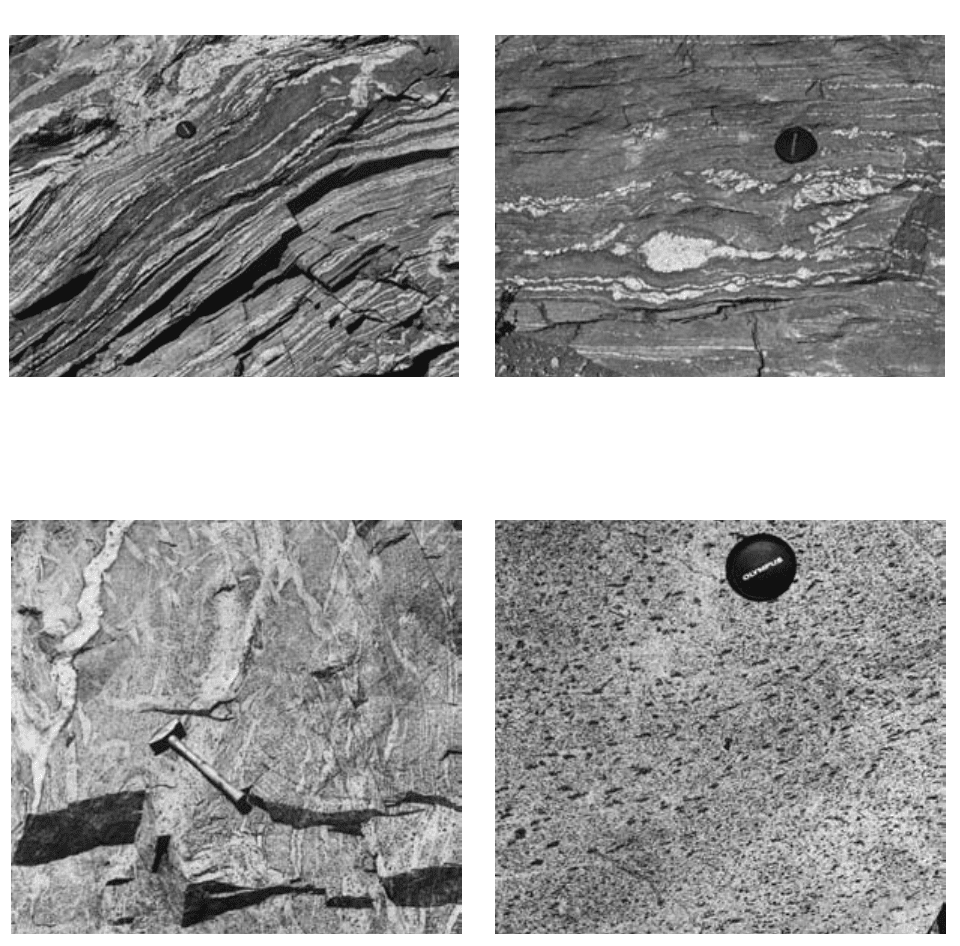
458 Igneous and Metamorphic Petrology
(a) (b)
in different ways in different places at different times,
some being magmatic and others metamorphic.
Deep crustal migmatites have long been regarded
as spawning grounds for granitoid plutons. However,
no direct genetic connection has been unequivoc-
ally demonstrated. One tentative conclusion is that
migmatites represent the culmination of prograde
metamorphism and are not embryonic granitic plutons.
Mylonite is a sheet-like, laminated body of fine-
grained rock developed in high-strain-rate ductile
shear zones that are the deep-seated counterparts of
brittle cataclastic fault rocks in the shallower crust
(Figure 8.9). The microcrystalline, streaked matrix
consists of intensely flattened, “smeared out” grains
surrounding larger, less (but still visibly) deformed
porphyroclasts defining a porphyroclastic or flaser
fabric (Figure 14.16c, d). Though usually visible, the
foliation is generally passive and does not control how
the rock breaks. Elongate mineral aggregates may
express a stretching lineation. A protomylonite is
15.12 Layered hornblende–plagioclase schist. The slabby character of the outcrop and ease of breaking into slabs qualifies the rock as a schist.
The well developed felsic segregations, which would qualify the outcrop as a gneiss for some geologists, possibly represent migmatitic
partial melts. Camera lens cap for scale. Proterozoic rocks in Black Canyon of the Gunnison River, Colorado.
(a) (b)
15.13 Migmatitic quartzo-feldspathic (felsic) gneiss. Note massive character of rock that does not weather or break along its subtle mechanic-
ally insignificant foliation. The rock may have been derived from a granitoid protolith; if true, it could be called an orthogneiss.
Precambrian terrane in the Colorado Front Range. (a) Irregular more felsic leucosome layers probably formed by partial melting and
segregation from the host rock. Note thin melanosome borders to left of and above and to right of and below hammer. Compare
Figure 15.15. (b) Close-up view, rotated 90° from (a) orientation, of more homogeneous mesosome (paleosome) gneiss between seg-
regated melanosome–leucosome layers. Weak foliation is defined by small lenticular mafic aggregates.
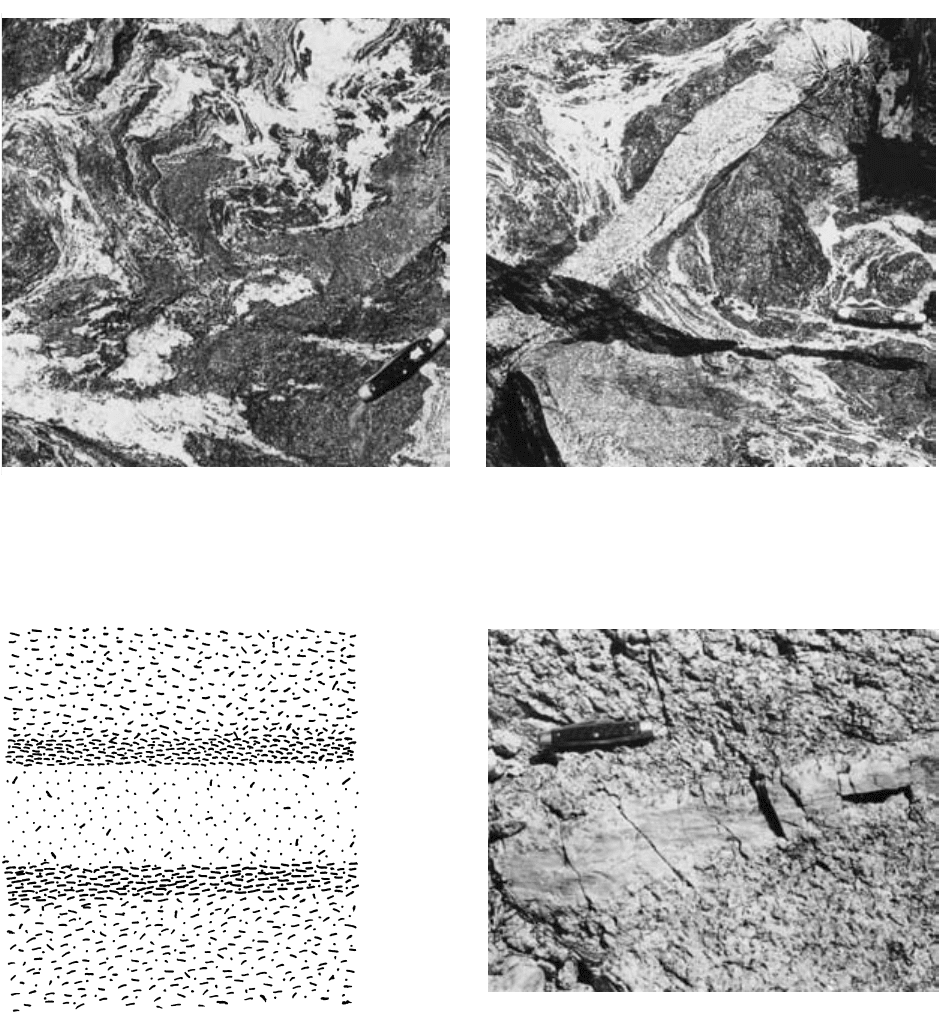
less deformed and has 50% porphyroclasts (Figure
14.16b), whereas the more deformed ultramylonite
(Figure 14.16d) has 10% porphyroclasts and matrix
grains are so minute (0.01 mm) that the hand sample
may resemble chalcedony or chert (Figure 15.16) or
even appear glassy, not unlike pseudotachylite (Special
Interest Box 11.1). Phyllonites are mylonites that con-
tain abundant phyllosilicates and have an S–C fabric
(see Section 17.3.5).
Mylonites can originate in any type of rock, but
seem best preserved in quartzo-feldspathic protoliths.
Study of mylonites by optical and electron micro-
scopy, with complementary laboratory experiments on
Petrography of Metamorphic Rocks: Fabric, Composition, and Classification
459
(a) (b)
15.14 Migmatite, Black Canyon of the Gunnison River, Colorado. Pocketknife is 8 cm long. (a) Irregular, contorted veins and pods of coarse
leucocratic felsic rock lie in finer-grained amphibolite. Note that the major leucocratic area at the top encloses material more mafic than
the host rock, as if the two resulted from segregation, or differentiation, of the original intermediate rock (a leucosome–melanosome–
paleosome relationship; compare Figure 15.13). (b) Similar to (a) except that a late granitic dike cuts across the migmatitic segregations.
Mesosome
(paleosome)
Melanosome
Leucosome
Melanosome
Mesosome
(paleosome)
15.15 Schematic segregation of felsic and mafic (dashes) minerals in
a migmatite resulting from in situ partial melting. Mesosome
is a descriptive term for rock intermediate in composition be-
tween mafic melanosome and leucosome, whereas paleosome
is a genetic term for the protolith.
15.16 Sheet of aphanitic ultramylonite in granite, Kern Mountains,
eastern Nevada. Note slight discordance between faint trace of
foliation in mylonite and its contact with the host granite.
Pocketknife is 8 cm long.
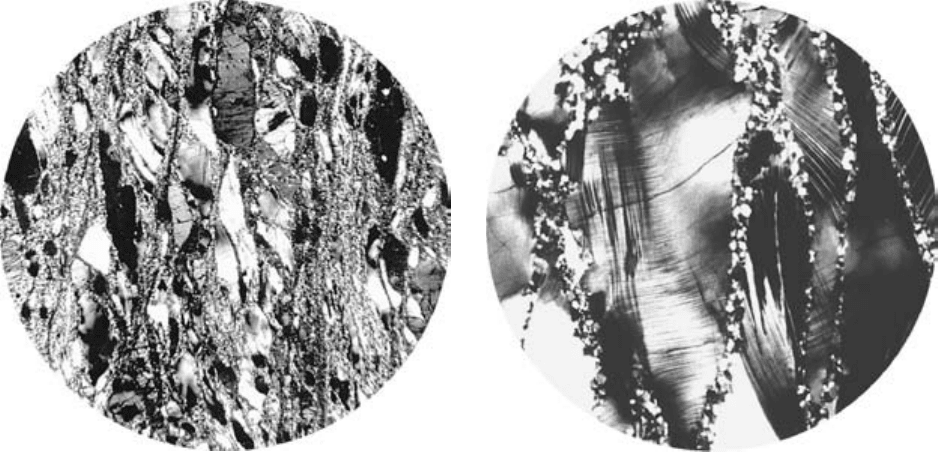
ductile deformation, has demonstrated that the typ-
ical, and once controversial, very fine grain size results
from dynamic recrystallization (Figure 15.17) rather
than by brittle pulverization. At high strain rates under
elevated P–T metamorphic conditions, drastically
straining grains simultaneously recrystallize into a
mosaic of tiny, strain-free grains.
15.2.4 Nonfoliated Mafic Rocks
Metamorphosed rocks of basaltic composition called
metabasites are widespread in regional metamorphic
terranes of orogenic belts. In Archean–early Protero-
zoic cratons, belts of low-grade metabasites lie between
more voluminous metamorphosed granitoids that are
now felsic orthogneisses (Figure 9.14). Metabasites
constitute much of the modern-day oceanic crust, frag-
ments of which are exposed in accreted terranes of
ophiolite on land in subduction zones.
Despite widespread nonhydrostatic states of stress,
granoblastic or only subtly foliated greenstones and
amphibolites appear to dominate over mineralogically
equivalent, strongly foliated schists. Inhomogeneous
deformation and uneven strain partitioning may allow
parts of metabasite bodies to escape development of
anisotropic fabric while adjacent parts or neighboring
rocks that have lesser ductile strength experience
ductile flow and development of tectonite fabric.
Greenstone is an aphanitic, mafic, low-grade meta-
morphic rock composed of a haphazard isotropic array
of combinations of epidote-group minerals, prehnite,
pumpellyite, chlorite, actinolite, albite, titanite, and
locally a carbonate mineral. This low-grade assem-
blage of minerals partially to completely replaces prim-
ary magmatic minerals but relict magmatic fabrics,
including pillows and amygdaloidal, porphyritic, and
ophitic texture (Figure 14.6a, b), are commonly pre-
served. With increase in metamorphic grade, complex
reactions over a range of T consume the lower grade
assemblage of albite, epidote, chlorite, and actinolite,
forming generally coarser grains of oligoclase–andesine
and aluminous hornblende that erase any vestiges of
protolith fabric in amphibolite.
Amphibolite is a widespread phaneritic rock type
made of plagioclase and hornblende (Figure 14.6c).
Depending on grade and bulk chemical composition,
almandine-rich garnet and pyroxene may also occur
in garnet amphibolites (Figure 14.8); subordinated
amounts of biotite, titanite, Fe–Ti oxides, and quartz
may also be locally present. Some petrologists use the
label amphibolite for any plagioclase–hornblende rock,
regardless of fabric. Although the rock type amphi-
bolite is the namesake for the amphibolite facies, the
common name, unfortunately, causes confusion. Not
all amphibolites belong to this facies nor is the entire
facies made up of amphibolite.
Eclogite is a very rare but geologically significant
rock that was the focus of considerable attention in the
late twentieth century (Smith, 1988; Carsell, 1990). The
460 Igneous and Metamorphic Petrology
15.17 Anorthosite mylonite from a shear zone in the Jotun nappe complex, Jotunheimen, Norway (Ji and Mainprice, 1990). The estimated T
during ductile deformation and concurrent dynamic recrystallization was about 600°C. Photomicrographs under cross-polarized light
courtesy of Shaocheng Ji. (a) Lenticular porphyroclasts of strained plagioclase (An
45
) in a granoblastic matrix of small polygonal
plagioclases resulting from dynamic recrystallization (see Section 17.2.4). Higher relief grain top center of view is clinopyroxene.
(b) Enlarged view of porphyroclasts. Strain is manifest in undulatory extinction and lenticular tapered deformation twins. Small,
unstrained polygonal grains along boundaries of porphyroclasts have completely replaced some narrow high-strain bands.
(a) (b)
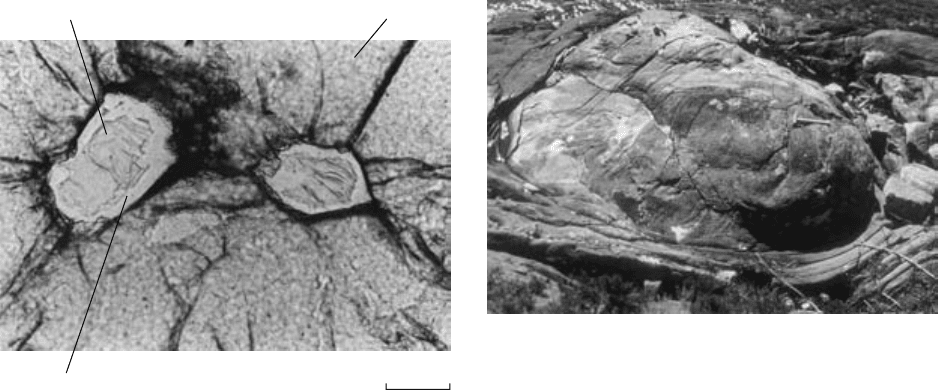
oceanic lithosphere before being exhumed by tec-
tonic and erosion processes.
2. As local layers, lenses, and boudins that are pos-
sibly relict dikes in amphibolite-facies migmatitic
felsic gneisses in the Caledonide orogen of western
Norway (Figure 15.19). More recent discoveries are
in continental sutures in the western Alps and east-
central China.
Coleman et al. (1965) classified eclogites into three
groups corresponding to these three petrotectonic
associations but emphasizing contrasts in the chemical
composition of the constituent clinopyroxenes and
garnets. Subsequent work has not entirely supported
the mineralogical distinctions. Because of their wide
range in equilibration T, Carswell (1990) adapted an
earlier proposal by S. Banno that subdivides eclogites
into three thermal categories:
1. High-T (900°C). Includes most mantle-derived
xenoliths in mafic and ultra-mafic magmatic host
rocks.
2. Medium-T (900–550°C). Includes some xenoliths
as well as eclogite intercalated with felsic gneisses.
3. Low-T (550°C). Associated with blueschist-facies
rocks in near-trench settings.
15.2.5 Nonfoliated High-Grade Felsic Rocks
Phaneritic granoblastic rocks are widespread in meta-
morphic terranes. Those composed mostly of calcite
are called marble, of quartz quartzite, and of plagio-
clase amphibole amphibolite. Those made mostly of
quartz and feldspar are called granofels. Biotites, if
present, are randomly oriented; other high-grade mafic
minerals such as amphiboles, pyroxenes, and garnets
do not contribute to a planar fabric. Granofelses are
typical of the upper amphibolite and higher grade
granulite facies. Protoliths include granitoids and
Petrography of Metamorphic Rocks: Fabric, Composition, and Classification
461
0.1 mm
Quartz
Coesite
Garnet
15.18 Partially replaced coesite grains enclosed within garnet in an
ultrahigh-P phengite-bearing eclogite, Guanjialing, Dabie
Mountains, central China. In the photomicrograph under
plane polarized light the ragged relics of high-relief coesite
(monoclinic, with a feldspar-like atomic structure) are rimmed
by low-relief, polycrystalline, replacement quartz. Note the
radial tensile cracks in the host garnet that were produced
as the larger molar volume (less dense) quartz replaced the
smaller molar volume (more dense) coesite. In the absence of
coesite, such cracks surrounding polygranular quartz provide
evidence for the former presence of the denser coesite poly-
morph. Sample CD41 described in Carswell et al. (1997).
Photomicrograph and caption courtesy of Tony Carswell.
exact definition, distinction from allied rocks, and con-
ditions of formation remain somewhat controversial.
As originally defined by R. J. Haüy in 1822, eclogite is
essentially a bimineralic rock composed of a red-brown
pyrope-rich garnet solid solution and a green clino-
pyroxene solid solution called omphacite whose end-
members are essentially jadeite and diopside (Appendix
A). Other common accessory constituents include quartz,
kyanite, orthopyroxene, rutile, and, rarely, coesite (Fig-
ure 15.18). Plagioclase is absent. These mineralogical
features as well as its much greater density (3.4–3.5
g/cm
3
) compared to its basaltic protoliths (Figure 8.15)
bespeak its equilibration under high pressures.
The occurrence of eclogite as mantle-derived
xenoliths in highly alkaline basaltic rocks, kimberlite,
orangeite, and lamproite has already been described
(Sections 11.2.1 and 13.12.2). Controversial possible
sources for the xenoliths are bodies of crystallized
basalt magma trapped in the mantle and transformed
basalt crust in ancient subducted oceanic lithosphere.
As noted by P. Eskola in 1921, eclogite also occurs in
two metamorphic terranes in orogens:
1. With blueschist-facies rocks in forearc settings near
the oceanic trench (Figure 14.24). These eclogites
are believed to be basalt crust that was metamor-
phosed while deeply buried in the subducted
15.19 Pod of coesite-bearing eclogite under hammer surrounded by
felsic paragneiss on the northeast shore of Nordpollen about
1 km northwest of Vetrhus, Norway (Carswell et al., 1999).
Photograph courtesy of Tony Carswell.
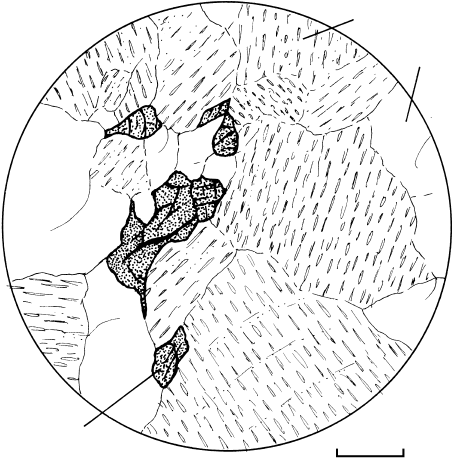
thoroughly reconstituted psammitic and pelitic meta-
sedimentary rocks. In the past, granofelses were called
granulites but this designation is not recommended
because of confusion with the facies of the same name.
Not all granulites of older geologic writings belong to
the granulite facies and other rock types occur in it.
Charnockite is a granofels consisting mostly of
perthitic alkali feldspar and quartz plus minor Fe-rich
orthopyroxene and plagioclase (Figure 15.20). Feldspars
are commonly dark green, brown, and red, and even
black. Antiperthitic plagioclases have small amounts
of exsolved alkali feldspar and alkali feldspars are
intergrowths of subequal amounts of K- and Na-
endmembers (mesoperthites). These two perthites
indicate high temperatures of equilibration under
granulite-facies conditions, followed by slow cooling.
Low water fugacities stabilize anhydrous mafic min-
erals in lieu of biotite and hornblende. Some quartz
grains in hand sample show an unusual blue opales-
cence due to the presence of minute needles of rutile
apparently formed by exsolution of TiO
2
originally dis-
solved in the quartz at high temperatures. The name
charnockite was coined by T. H. Holland in 1900 from
the tombstone of Job Charnock at St John’s Church,
Calcutta, India!
Charnockite is one rock type within the charnockitic
rock suite that includes other, more plagioclase-rich
felsic phaneritic rocks in which the dominant mafic
mineral is orthopyroxene. (In lieu of the detailed classi-
fication of the charnockitic rock suite in Le Maitre
(1989, p. 13), they can simply be referred to as ortho-
pyroxene monzonite, orthopyroxene granodiorite, and
so on depending on their modal composition and prob-
able magmatic protolith.) Garnet and clinopyroxene
may also occur in charnockitic rocks that are wide-
spread in Proterozoic associations with anorthosite
and related gabbroic rocks (see section 19.5.2). Some
petrologists question whether charnockitic rocks are
metamorphic, originating by recrystallization in the
solid state from a granitoid protolith. Alternatively,
they may be magmatic, crystallizing directly from dry
hot magmas (Kirkpatrick and Ellis, 1992) under
granulite-facies conditions, in contrast to the biotite–
hornblende-bearing magmas of widespread Mesozoic–
Cenozoic continental arcs. Magmatic charnockitic
rocks may have suffered overprinting subsolidus grain
boundary adjustment during very slow cooling—a sort
of autometamorphism. This would confuse their origin
with rocks produced by a distinct episode of metamor-
phism independent of, and perhaps tens to hundreds
of millions of years after, the origin of the protolith.
15.2.6 Other Nonfoliated Metamorphic Rocks
Quartzite forms by recrystallization of relatively pure
quartz sandstones. In such protoliths, rounded detrital
quartz grains that are typically outlined by adhering
clay or other foreign particles have recognizable optic-
ally continuous overgrowths of cementing quartz. In
metamorphic quartzites, recrystallization has essen-
tially or completely erased this clastic texture and pro-
duced a granoblastic aggregate. Quartz grains in some
quartzites may be somewhat strained and others may
have ragged, sutured margins resulting from deforma-
tion and dynamic recrystallization. Massive quartzites,
possibly with relict bedding, grade into laminated or
slabby quartz schists in which thin folia of mica altern-
ate with thicker lenses and layers of quartz; protoliths
were thinly bedded shaly sandstones. Marbles, schists,
phyllites, and slates representing metamorphosed lime-
stones and shales are commonly interlayered with
quartzites in metasedimentary sequences.
Some quartzites are coarse-grained metacherts
derived from deep marine deposits that contain Mn-
silicates, such as piemontite (an epidote-like mineral)
and spessartine garnet.
Metamorphism of relatively pure limestone and
dolomite yields generally phaneritic marble (Figure
14.4b) and dolomite marble, or dolomarble, respect-
ively. Impure carbonate protoliths that contain vari-
able amounts of quartz sand grains and shaly material
may have, in addition to calcite and dolomite, quartz,
diopside, tremolite, talc, phlogopite, wollastonite, calcic
plagioclase, vesuvianite, forsterite, and grossular–
andradite. Relict bedding may be preserved. Gray
coloration, often uneven and streaked, in otherwise
pure marbles is produced by minute specks of graphite
or other minerals. But graphite and carbonaceous
462 Igneous and Metamorphic Petrology
Perthite
Quartz
Orthopyroxene
0mm1
15.20 Charnockite from Madrasteria, St Thomas Mountain, Salem
District, India. The Fe-rich orthopyroxene is strongly
pleochroic green to pink. Sample courtesy of A. P. Subramanian.
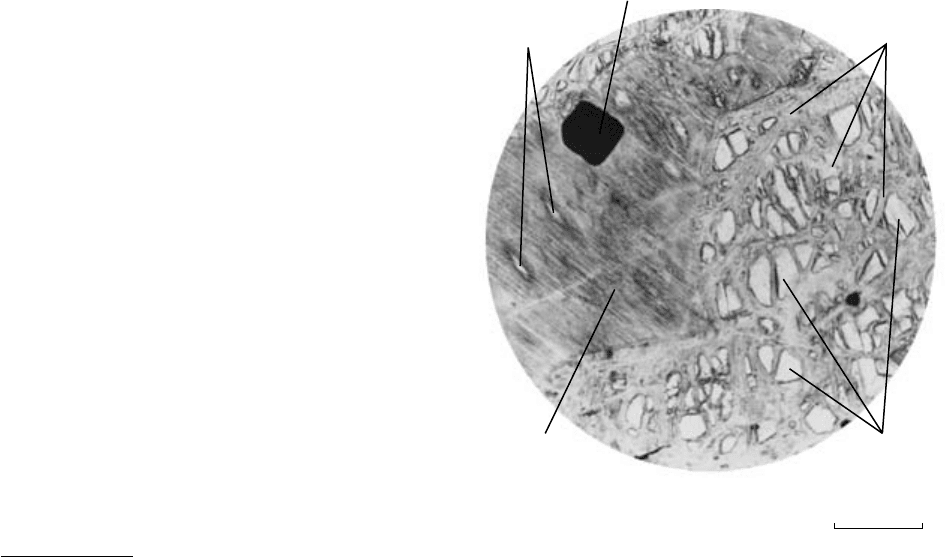
material can react with water under metamorphic
conditions, liberating CO
2
and CH
4
that leaves the
rock snow-white (see Special Interest Box 16.2).
Hornfels results from thermal metamorphism within
contact aureoles surrounding magmatic intrusions.
Granoblastic fabric is typical and grain size ranges
from fine phaneritic to aphanitic; conchoidal fracturing
occurs in very fine-grained hornfelses. Relict bedding
may be present. Protoliths range widely in composition
in aureoles. High-grade derivatives of mafic rocks are
combinations of plagioclase, hornblende, pyroxene,
and Fe–Ti oxides. Metamorphism of impure carbonate
rocks consist of Ca–Al–Mg–Fe silicates, such as tremo-
lite, diopside, wollastonite, forsterite, and so on. Pelitic
hornfelses commonly contain poikiloblastic cordierite
and/or andalusite (Figure 14.25c, d).
15.2.7 Serpentinite
This generally massive, nonfoliated rock type consti-
tutes a large proportion of ophiolites emplaced in near-
trench sectors of contractional orogens and, therefore,
merits special attention.
Serpentinites are ultramafic, typically aphanitic
rocks composed mostly of serpentine, together with
accessory magnetite, brucite, other Mg-silicates, and
Ca–Al-silicates (O’Hanley, 1996). Most protoliths are
ultramafic rocks that contain abundant Mg-rich oli-
vine and/or pyroxene; that is, peridotite, dunite, and
pyroxenite. However, rare metasomatized gabbro and
dolomite may also be protoliths. Serpentinites have a
bewildering array of fabrics on all scales of observation
as well as colors, but most are shades of yellow and
green ranging to black. Their color and mottled
scaly appearance is the basis of the name from the
Latin serpentinus, meaning serpent rock. Weathered
surfaces can be also be shades of orange, red, and
brown.
Three low- to medium-grade serpentine minerals—
lizardite, antigorite, and chrysotile—are all approxim-
ately Mg
3
Si
2
O
5
(OH)
4
but limited amounts of Fe
2
,
Fe
3
, and Al can substitute for Mg and Si. Because of
subtle chemical contrasts, as well as differences in
atomic structure, these three minerals are not poly-
morphs with separate P–T stability fields. Both anti-
gorite (stable up to 550°C) and lizardite (300°C) are
platy, whereas chrysotile (300°C) consists of scrolled
layers manifest in fibrous form as asbestos. All three are
found in subgreenschist-facies rocks, lizardite and
antigorite in blueschist-facies rocks, and antigorite in
greenschist- and amphibolite-facies rocks.
Serpentinization. A wide range of fluid compositions
are apparently involved in the open-system serpentin-
ization of Mg-rich anhydrous protoliths, but fluids must
be essentially aqueous in order to create serpentine
minerals that contain 12–14 wt.% water. Some serpen-
Petrography of Metamorphic Rocks: Fabric, Composition, and Classification
463
Residual
Cr-Fe spinel
Mesh-textured
serpentine
l
olivine grainof orthopyroxene
0.50mm
15.21 Partially serpentinized peridotite (harzburgite). Serpentine
replacement of olivine progressed inward from internal frac-
tures as water moved in, creating mesh texture. Serpentine
has mostly replaced primary orthopyroxene, creating bastite
texture. Primary Cr–Fe spinel is unaltered.
tinites form by interaction between ocean water and
hot ultramafic rocks at spreading ridges, whereas other
protoliths are serpentinized by lower
18
O meteoric
waters (Figure 2.24) on continents. Locally unusually
low fugacities of oxygen during serpentinization are
indicated by the occurrence of secondary native iron
(Fe
0
) and Fe
0
–Ni–Co alloys. Ferrous iron in magmatic
olivines and pyroxenes apparently reacts with oxygen
in infiltrating water to form magnetite (Fe
2
Fe
O
4
),
while H liberated from the dissociated water reduces
other Fe, Ni, and Co to their metallic state (Frost,
1985). Some protoliths serpentinized at ocean ridges
can be subsequently overprinted by thermal, tectonic,
and fluid-induced metamorphism as they are emplaced
into accretionary prisms as ophiolite (Section 13.6).
Serpentine replacement of olivine grains begins by
hydration reactions along cracks, yielding after com-
plete serpentinization a mesh texture (Figure 15.21).
In contrast, replacement of chain silicates, such as
orthopyroxene, creates a so-called bastite texture. Relict
fabrics can be obliterated by penetrative deformation
under nonhydrostatic stresses. Bodies of serpentinite
are mechanically weak and fault movement is com-
monly focused in them. In sheared serpentinite, a
multitude of differently oriented, polished slip surfaces
(slickensides) can be visible in hand sample.
2
3
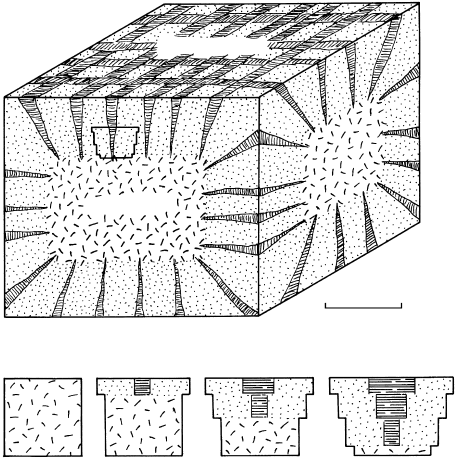
Simple hydration of peridotite to serpentine miner-
als without any change in proportions of other chem-
ical constituents theoretically results in a decrease in
density of 20% from 3.3 to 2.65 g/cm
3
. But whether
serpentinization actually proceeds in this manner and
results in a volume increase or proceeds without a
change in volume as some original components are
removed has been controversial for many decades. Two
model reactions involving olivine exemplify these two
end-member processes:
15.1 2Mg
2
SiO
4
3H
2
O Mg
3
Si
2
O
5
(OH)
4
Mg(OH)
2
forsterite serpentine brucite
88 cm
3
111 cm
3
25 cm
3
V 48 cm
3
15.2 6.15Mg
2
SiO
4
6H
2
O 2Mg
3
Si
2
O
5
(OH)
4
forsterite serpentine
271 cm
3
221 cm
3
865 g 90 g 554 g
2Mg(OH)
2
4.3MgO 2.15SiO
2
brucite removed in solution
49 cm
3
116 g 173 g 129 g
V 0
Resolution of this controversy has far-reaching geo-
logic implications that go beyond just the nature of the
serpentinization itself. For example, if serpentinization
involves a volume increase in the thin oceanic litho-
sphere at spreading ridges some of the uplift might be
related to infiltration of seawater into hot peridotite in
this extensional rift environment. The global budget
of Mg and Si in the oceans could depend on which
reaction prevails in the ridge metasomatic system.
Advocates of a constant volume replacement (reac-
tion 15.2) cite preservation of relict magmatic textures
in serpentinized peridotite; primary grain outlines on
the scale of millimeters do not seem to show expansion.
Yet voluminous Mg- and Si-metasomatism in neigh-
boring rocks is not always apparent. On a larger out-
crop scale of tens of meters, it is impossible to evaluate
volume changes because of nearly ubiquitous shear
zones that cut through the serpentinite body, confusing
the issue of whether the deformation is related to ex-
pansion or to tectonic emplacement. O’Hanley (1992)
points out that with the predicted volumetric expan-
sion during serpentinization the change in dimensions
of relict olivine and pyroxene grains is only on the
order of hundredths of a millimeter, which is too small
to be reliably discerned. However, the cumulative
effect of volumetric expansion might be more apparent
on the scale of tens of centimeters to perhaps a meter.
Indeed, he documents instances where unsheared
outcrops consist of distinct, fracture bounded blocks,
or “kernels,” of this dimension of peridotite that are
surrounded by serpentinite grading inwardly into less
altered rock. Serpentine-filled fractures radiate from
the interior of the kernel and become wider outward,
consistent with their development during progressive
inward serpentinization and volumetric expansion of
the block of peridotite (Figure 15.22). Some petrolo-
gists have documented a constant ratio between SiO
2
and (MgO CaO MnO NiO total Fe oxide)
in variably serpentinized peridotites, ruling out reac-
tion 15.2 and supporting 15.1.
Ca in serpentinizing pyroxenes, especially Ca-rich
clinopyroxenes, in ultramafic protoliths cannot be
sequestered in serpentine minerals or several common
accessory phases. It consequently must exit the open
system, and is presumed to migrate via advecting fluids
into adjacent rock where it produces metasomatic
rodingite. A wide variety of protoliths adjacent to ser-
pentinizing rock can be so metasomatized into Ca-rich,
silica-poor assemblages of epidote group minerals, Ca-
rich garnet, diopside, prehnite, vesuvianite, and many
other Ca–Al minerals. Na purged from the metasoma-
tizing rocks can in turn form nearby metasomatic
464 Igneous and Metamorphic Petrology
Peridotite
Serpentinite
~0.5 m
Initial
t
1
t
2
t
3
15.22 Kernel pattern and cross-fractures in serpentinized peridotite.
Redrawn from O’Hanley (1992). As serpentinization penetrates
into the core of peridotite, the accompanying volume increase
produces tensile fractures in the surrounding serpentinite jacket.
Progressive inward serpentinization creates outwardly wider
chrysotile-filled fractures, as shown at successive steps in time
t
1
, t
2
, and t
3
. Actual expansion and fracturing is more contin-
uous. Fractures are oriented radially around the core, essentially
perpendicular to the sharp core–rim interface, and, in a plane
parallel to it, form a grid-pattern visible in top of the block.
albitites or, at higher pressures in a subduction setting,
jadeitic rocks.
Intimate mixtures of green serpentinite and white
carbonate rock, seen in polished floor tiles and build-
ing façades, is called ophicalcite, from the Greek
ophites, meaning like a serpent. The carbonate is
commonly introduced into openings in cataclastic
serpentinite formed in fault zones.
15.2.8 Metasomatic Rock Types
Generally nonfoliated rocks originating by replacement
of pre-existing minerals are described in the following
paragraphs. Serpentinite could have been included here.
Skarn is a calc-silicate rock produced by metaso-
matic replacement of predominantly carbonate rock
(limestone and dolostone) by Ca–Mg–Fe–Al silicates
(Einaudi et al., 1981). Replacement is accomplished by
advecting hydrothermal solutions usually derived from
a nearby magmatic intrusion and on a smaller scale by
interdiffusion of components at boundaries between
layers of silicate and carbonate rock in contact and
regional settings. A wide variety of silicate minerals
are formed in contact aureoles, including diopside–
hedenbergite, vesuvianite, grossular–andradite, scapolite,
and epidote minerals. Economically valuable deposits
of magnetite as well as sulfides and oxides of Cu, Mn,
Zn, and Pb also occur locally. Most of the world’s
tungsten (W) is obtained from scheelite, CaWO
4
, and
wolframite, (Fe,Mn)WO
4
, in skarns.
Jasperoid is produced in much the same manner as
skarn by advecting silica-laden hydrothermal solutions,
usually derived from nearby magmatic intrusions.
Limestone and dolostone are replaced to varying de-
grees by microcrystalline quartz so that the protolith
appears unchanged, even preserving a dark gray color.
Jasperoid is locally host to economic deposits of Au,
Ag, and other metals.
Greisen is a metasomatized granitic rock, commonly
of the S-type, produced by interaction with hydrother-
mal solutions having high concentrations of F, B, Li,
W, and Sn. Very large time-integrated fluid/rock ratios
create a greisen composed chiefly of quartz and Li-
bearing mica (muscovite, zinnwaldite, or lepidolite)
plus accessory topaz, tourmaline, fluorite, rutile, cassi-
terite, and wolframite. Some greisens are economic
resources of the listed elements.
Fenite is a syenitic product of alkali metasomatism
of felsic country rock surrounding intrusions of car-
bonatite and some highly alkaline magmas (Figures
13.39 and 13.40). The fenitizing Na–K-rich solutions
desilicate the protolith by replacing any unstable
quartz by Na–Fe-rich amphibole and/or pyroxene
(Figure 14.21), whereas alkali feldspar remains stable.
Apatite and titanite are accessories.
Rodingite is a massive light-colored rock composed
of Ca-rich minerals produced by infiltration of Ca-
bearing solutions into rocks surrounding serpentiniz-
ing ultramafic protoliths.
Spilite is a metasomatized basalt produced by hydro-
thermal activity at ocean ridges and more locally by
burial metamorphism. Ca has been removed (chiefly
from primary calcic plagioclase), along with transition
metals such as Cu, Ni, Co, and Mn, while Na, H
2
O,
and perhaps Mg have been added. Ti and Al remain
constant. The metasomatic assemblage is of low-grade
albite–oligoclase chlorite tremolite–actinolite and
locally includes epidote, pumpellyite, prehnite, and
quartz. A light gray (in thin section) aggregate of cryp-
tocrystalline titanite (“leucoxene”) commonly replaces
primary Fe–Ti oxides. Magmatic clinopyroxenes and
protolith textures may only partially be replaced. Wide-
spread amygdules are of chalcedony, opal, chlorite,
calcite, and hydrous Ca–Al silicates. First recognized
over 150 years ago as pillow lavas within ophiolitic
sequences, spilites were believed to have have crystal-
lized directly from a unique spilitic magma.
The protolith of rare anthophyllite–cordierite rocks
has been a long-standing controversy, but they are now
believed to originate by recrystallization at moderate-T
and moderate- to low-P of highly metasomatized,
Ti–Ca–Na-poor, ocean ridge basalts.
15.2.9 Misfits
Inevitably, there will be rocks that cannot be appro-
priately matched to any of the foregoing defined
rock types. Common misfits are weakly or nonfoliated
rocks of variable grain size and commonly composed
of a partially retrograded mineral assemblage. These
may simply be called “rock” with an appropriate com-
positional qualifier, such as feldspar–quartz–chlorite
rock.
15.2.10 High-Strain-Rate Rocks in Fault and
Shear Zones
Brittle to ductile rock-forming processes (Sections 8.2
and 14.1.3) operate where bodies of rock slip rapidly
past one another. During shallow crustal low-T faulting,
brittle rock is mechanically broken, crushed, and pul-
verized to form a structureless (isotropic) mass of angu-
lar fragments possessing cataclastic fabric (Figure 8.7).
Coarser fragments make up tectonic or fault breccia,
whereas more thoroughly and intensely pulverized
sandy to clay-like material is fault gouge. Subsequent
cementation of these cohesionless porous materials
may occur where dissolved minerals precipitate from
infiltrating ground water, forming a solid cataclastic
rock. This term is also used for a nonfoliated cohesive
rock formed by processes transitional between brittle
and ductile. Very local melting can create pseudo-
tachylite (Special Interest Box 11.1).
Ductile deformation in generally deep crustal shear
zones creates fine grained, cohesive mylonite.
Petrography of Metamorphic Rocks: Fabric, Composition, and Classification
465

15.2.11 Veins
Veins are a widespread feature of metamorphic terranes,
regardless of their grade. In contrast to magmatic dikes,
veins are typically a result of advecting hydrothermal
solutions that precipitate minerals into openings in
the rock mass. Their size, form, composition, source
of fluids, and chronology relative to deformation and
recrystallization in the wall rock can be complex, as
discussed by Fry (1984) and Barker (1990).
Veins range from microscopic dimensions to meters
in thickness and tens to hundreds of meters in length.
Some are planar sheets of uniform thickness, whereas
lenticular (Figure 15.8) and irregularly shaped ones
(Figure 15.23) seem more common. Like dikes, they
can be discordant to wall rock structure or be hosted in
isotropic rock, but many are more or less concordant to
foliation in the host rock. Many vary from concordant
to discordant along their extent.
Some veins are monomineralic, consisting of calcite
or epidote (in granitoids such as Figure 14.27). But
the most common vein is of white quartz; locally
these may carry economic concentrations of gold, as in
the “Mother Lode” of the Sierra Nevada Foothills,
California. Fewer veins consist of two or more con-
spicuous minerals.
Vein-forming fluids are high-T solutions of H
2
O
and usually lesser CO
2
in which various chemical
species, especially silica, are dissolved. Although some
may be expelled from nearby crystallizing bodies of
volatile oversaturated magma, most fluids are derived
from within the metamorphic rock, either as ground-
water heated by a nearby magma (Figure 4.12), or
liberated from rocks undergoing prograde devolatiliza-
tion reactions during metamorphism. Fluid migration
is governed by gradients in fluid pressure, P
f
, and by
bulk rock permeability (Section 8.5). Devolatilizing
carbonate-bearing rocks subjected to prograde meta-
morphism tend to develop grain-scale permeabilities
so that fluids migrate by porous flow along grain
boundaries; consequently, veins are scarce. On the
other hand, in silicate rocks permeabilities tend to be
less and as P
f
increases during prograde reactions it
can exceed the tensile strength of the rock, creating
hydraulic fractures (Section 8.2.1) that can either cut
across host rock foliation or insinuate along it. The
fluid immediately moves into the crack where minerals
may precipitate as the solution is chemically or ther-
mally perturbed by the wall rock. This crack-seal
mechanism can be repeated many times in the his-
tory of a metamorphic terrane, producing multistage
vein growth. Vein fabric and mineral assemblages can
potentially provide insights into prograde mineral reac-
tions; vein minerals having restricted P–T stabilities
(such as andalusite, kyanite, jadeite) are especially
useful in recording the character of advecting fluids
associated with metamorphism.
15.3 GRAPHICAL REPRESENTATION OF
MINERAL ASSEMBLAGES IN
COMPOSITION DIAGRAMS
A composition, or chemographic, diagram that can
represent the correspondence between the stable
mineral assemblages in rocks and their bulk chemical
composition is of paramount importance and utility in
metamorphic petrology. Such diagrams permit easy visu-
alization of what minerals can stably coexist together
under restricted conditions of P, T, and fluid composi-
tion in a rock of particular chemical composition, as
well as contrasts in mineral assemblage depending on
contrasts in rock compositions. Comparisons can be
made, for example, among assemblages in different
zones in pelitic rocks in a regional Barrovian terrane by
using several diagrams to represent the differing con-
ditions of their metamorphism. Although the assump-
tions and simplifications made in the construction of
composition diagrams (e.g. Thompson, 1982; Winter,
2001, pp. 487–93) compromise thermodynamic rigor,
which means that they cannot represent exact states
of equilibrium in all cases, their advantages outweigh
shortcomings.
15.3.1 Fundamentals
The basis of a chemographic diagram is rooted in the
phase rule (Section 5.1.1). In divariant mineral assem-
blages where both P and T can be freely and inde-
pendently varied without any perturbation in the state
of equilibrium, compositional variables (X) are also
usually significant, increasing the degrees of freedom,
so that F 2. The common recurrence of certain min-
eral assemblages in metamorphic terranes around the
world is consistent with at least divariant equilibria
where P, T, and X were independent variables, such as
within a particular mineralogical zone in a regional
466 Igneous and Metamorphic Petrology
15.23 Veins of white quartz in schist.
